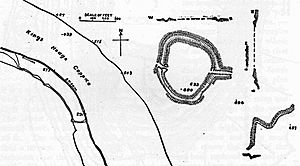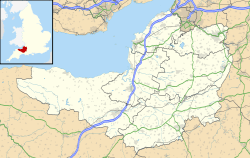Bat's Castle facts for kids
|
Caesar's Camp
|
|

Plan of earthworks at Bat's Castle
|
|
| Location | Carhampton, Somerset, England |
|---|---|
| Coordinates | 51°10′11″N 3°26′59″W / 51.16972°N 3.44972°W |
| Altitude | 213 m (699 ft) |
| Type | Hillfort |
| History | |
| Periods | Iron Age |
| Reference no. | 36896 |
| Identifiers | |
| NHLE | 1007667 |
| Atlas of Hillforts | 4060 |
Bats Castle is an ancient hill fort from the Iron Age. It sits on top of a hill that is 213 meters (about 700 feet) high. You can find it near Carhampton in Somerset, England.
This special place was once known as Caesar's Camp. It might also be connected to another old site called Black Ball Camp.
Contents
A Lucky Discovery
In 1983, something exciting happened at Bats Castle. Some schoolboys were exploring the area. They found eight old silver-plated coins! These coins were very old, dating from 102 BC to AD 350. This discovery helped experts identify the site as an important historical place.
What Does It Look Like?
Bats Castle is built on the highest part of Gallox Hill. It has two stone walls, called ramparts. It also has two ditches around it. These features were built to protect the people inside.
Today, some parts of the ramparts are damaged. The hill fort is also partly covered by bushes and trees. Even so, you can still see its impressive ancient design.
Ancient Stories and Legends
Bats Castle might have a legendary name: Din Draithou. This name comes from old stories. It is said to be a fortress built or used by a famous Irish king. This king was named Crimthann mac Fidaig. These legends add to the mystery of Bats Castle.
Why Were Hill Forts Built?
Hill forts like Bats Castle were built a long time ago. They appeared in Britain during the Late Bronze Age and Early Iron Age. This was around 1000 BC.
People built these forts for different reasons. They might have been military sites. Perhaps they were built to defend against invaders. They could also have been places for communities to gather safely.
As more people lived in Britain, there was more pressure on farming land. This could sometimes lead to arguments or even small wars. Hill forts offered a safe place during these times. They were strongholds where people could protect themselves.
Archaeologists believe that these forts were not always built because of war. Instead, they were ready if tensions grew. Some forts were attacked, but their main purpose was often to provide a secure home for the community.


